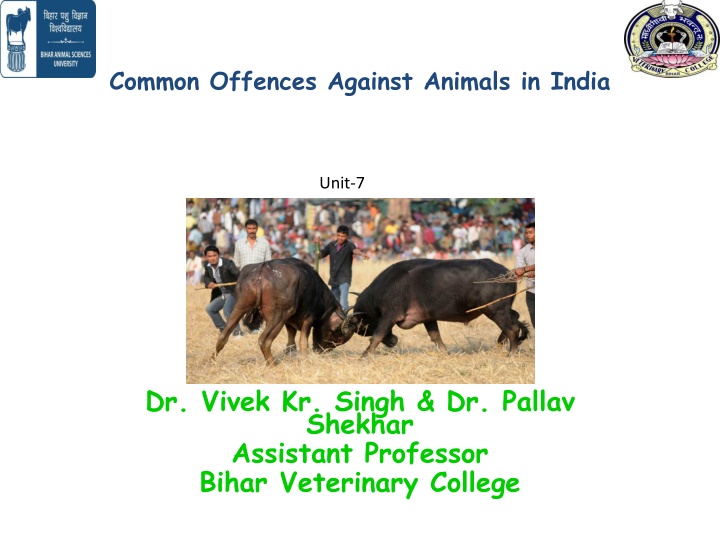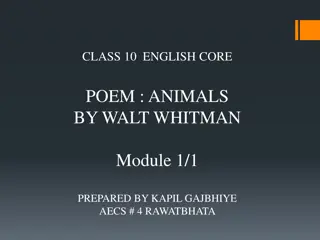Common Offences Against Animals in India: Understanding Mischief, Cruelty, and Bestiality
Offences against animals in India encompass mischief, cruelty, and bestiality. Mischief involves killing, poisoning, and maiming animals, punishable under the IPC. Maiming makes animals permanently useless, often to harm owners. Cruelty includes beating, overloading, starvation, and other forms of abuse. Bestiality, carnal intercourse against nature, is unfortunately prevalent in India. Understanding these offences is crucial for animal welfare and legal justice.
Download Presentation

Please find below an Image/Link to download the presentation.
The content on the website is provided AS IS for your information and personal use only. It may not be sold, licensed, or shared on other websites without obtaining consent from the author.If you encounter any issues during the download, it is possible that the publisher has removed the file from their server.
You are allowed to download the files provided on this website for personal or commercial use, subject to the condition that they are used lawfully. All files are the property of their respective owners.
The content on the website is provided AS IS for your information and personal use only. It may not be sold, licensed, or shared on other websites without obtaining consent from the author.
E N D
Presentation Transcript
Common Offences Against Animals in India Unit-7 Dr. Vivek Kr. Singh & Dr. Pallav Shekhar Assistant Professor Bihar Veterinary College
There are three common offences against animals in India Mischief Cruelty against animals Bestiality
Mischief This includes killing, poisoning and maiming an animal. Poisoning is the commonest method of mischievous killing. Abrus precatorius seed, Arsenic, Aconite root Datura leaves and seed of yellow oleander are common poisons used in the mischievous killing of the animals. Mischief is punishable under Section 428 and Section 429 I.P.C.
Maiming Maiming means making an animal permanently useless by the use of violence This type of offence is also common and its aim is to harm the owner when his animal damages the crop or other property
The common forms of hurting animals and rendering them useless are Fracture of bone cutting tendons of legs and neck injury to udder in milch animals Tearing of the vagina or rectum by introducing sharp or blunt object Punctured wounds etc
Cruelty against animals It includes beating, overloading, using a diseased animal for work, starvation, Phuka etc. PHUKA :- or doomdev includes the process of introducing air or any substance into the female organ of a milch animal with the object of drawing off from the animal any secretion of milk. These acts are punishable under the Prevention of Cruelty to Animals Act., 1960
Bestiality BESTIALITY :- Means carnal intercourse with man, woman or animal against the order of nature This type of crime is more frequent in India due to The common belief among illiterate people is that intercourse with a she donkey is a remedy for gonorrhoea Excessive sexual desire with less opportunity for natural intercourse
Young villagers who go out to graze cattle in fields far away from human eye, are incited, owing to loneliness and the proximity of the animals to commit this crime People having some mental abnormalities
Examination of Bestiality Cases Examination of the accused Examination of the animal
Examination of the accused The examination of the accused in a sexual offence be performed as soon after the alleged incident Name of accused, his father s/guardian s name, address, age are to be noted Number and date of requisition The place, date and time of commencement of examination are also to be noted The clothes of the suspect will smell of urine or faeces of the animal as after a sexual act animals have a habit of urinating
Examination of Animal for bestiality The vagina of the animal should be examined for evidence of injury The surrounding hair of the animal should be examined for the presence of human spermatozoa (it is important to note whether the spermatozoa found are of the same animal or not and for this purpose the presence or absence of heat in the female animal is also a guide) The presence of organisms of gonorrhoea (bean- shaped, gram negative diplococci) in the vagina of the animal is a definite sign of bestiality
EXAMINATION OF SEMINAL STAINS In the case of bestiality, presence of human seminal fluid in or around the parts of the animal is essential. Detection of human spermatozoa in a smear from the vagina of the animal and that from the discharges adhering to the surrounding hair is a positive proof
Examination of seminal stains may be carried out by the following method Physical Examination :- Average volume of ejaculate, average concentration (million per ml), pH, colour, consistency. Chemical Examination :- (1) Florence s Test and (2) Barberio s Test Microscopic Examination :- Serological Examination:- (precipitation test)
CHEMICAL EXAMINATION FLORENCE S TEST :- Potassium iodide Iodine Distilled water 30 ml 1.65 g 2.54 g PROCEDURE :- Prepare thick smear of seminal fluid and place over slip. One or two drops of Florence s solution allowed to run in-under the cover slip Large brown haemin like needle shaped crystals of choline per-iodide will shortly be formed in the presence of semen
BARBERIOS TEST :- PROCEDURE :- Prepare a thick smear of seminal fluid and place a cover slip. One or two drops of concentrated picric acid solution is allowed to run in-under the cover slip Yellowish needle shaped crystals of spermin picrate will be formed in the presence of semen
Bestiality is punishable under Section 377 I.P.C. The offenders are usually caught red-handed























